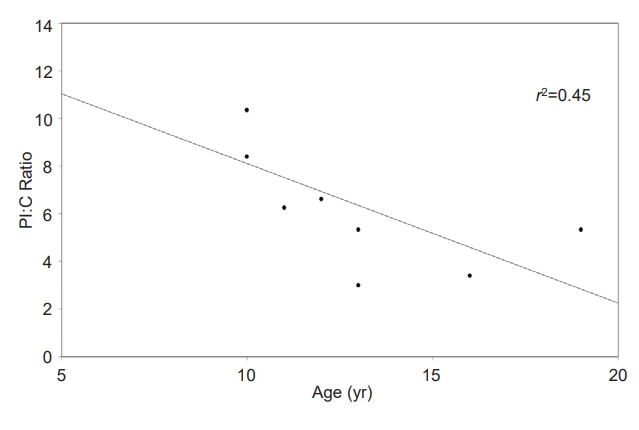Ann Pediatr Endocrinol Metab.
2020 Mar;25(1):38-41. 10.6065/apem.2020.25.1.38.
Comparison of proinsulin to C-peptide ratio in children with and without type 1 diabetes and its relation to age
- Affiliations
-
- 1Baylor University, Waco, TX, USA
- 2Pennington Biomedical Research Center, Baton Rouge, LA, USA
- KMID: 2501035
- DOI: http://doi.org/10.6065/apem.2020.25.1.38
Abstract
- Purpose
This study aimed to compare the proinsulin to C-peptide (PI:C) ratio in those with recent-onset type 1 diabetes versus those with no diabetes and to explore the effect of age on PI:C ratio.
Methods
Nineteen participants (n=9 with type 1 diabetes and n=10 with no diabetes) between 10 and 19 years of age were enrolled in a single-visit cross-sectional study and underwent blood collection after 10 hours fasting to measure proinsulin and C-peptide levels as well as other glycemic parameters.
Results
The median PI:C ratio was significantly different between type 1 diabetes and nondiabetes groups (6.24% vs. 1.46%, P<0.01). A significant negative correlation was seen between PI:C ratio and patient age after adjustment for duration of diabetes (r2=0.61, P=0.02) in the type 1 diabetes group.
Conclusion
Even in this narrow age window, a higher degree of β-cell dysfunction indicated by a higher PI:C ratio was seen in younger children.
Keyword
Figure
Reference
-
References
1. Schölin A, Nyström L, Arnqvist H, Bolinder J, Björk E, Berne C, et al. Proinsulin/C-peptide ratio, glucagon and remission in new-onset Type 1 diabetes mellitus in young adults. Diabet Med. 2011; 28:156–61.2. Evans-Molina C, Hatanaka M, Mirmira RG. Lost in translation: endoplasmic reticulum stress and the decline of β-cell health in diabetes mellitus. Diabetes Obes Metab. 2013; 15 Suppl 3:159–69.3. Sims EK, Chaudhry Z, Watkins R, Syed F, Blum J, Ouyang F, et al. Elevations in the fasting serum proinsulin-to-C-peptide ratio precede the onset of type 1 diabetes. Diabetes Care. 2016; 39:1519–26.
Article4. Loopstra-Masters RC, Haffner SM, Lorenzo C, Wagenknecht LE, Hanley AJ. Proinsulin-to-C-peptide ratio versus proinsulin-to-insulin ratio in the prediction of incident diabetes: the Insulin Resistance Atherosclerosis Study (IRAS). Diabetologia. 2011; 54:3047–54.
Article5. Ludvigsson J, Heding L. Abnormal proinsulin/C-peptide ratio in juvenile diabetes. Acta Diabetol Lat. 1982; 19:351–8.
Article6. Watkins RA, Evans-Molina C, Terrell JK, Day KH, Guindon L, Restrepo IA, et al. Proinsulin and heat shock protein 90 as biomarkers of beta-cell stress in the early period after onset of type 1 diabetes. Transl Res. 2016; 168:96–106.
Article7. Leete P, Willcox A, Krogvold L, Dahl-Jørgensen K, Foulis AK, Richardson SJ, et al. Differential insulitic profiles determine the extent of β-cell destruction and the age at onset of type 1 diabetes. Diabetes. 2016; 65:1362–9.
Article8. Mirmira RG, Sims EK, Syed F, Evans-Molina C. Biomarkers of β-cell stress and death in type 1 diabetes. Curr Diab Rep. 2016; 16:95.
Article9. Truyen I, De Pauw P, Jørgensen PN, Van Schravendijk C, Ubani O, Decochez K, et al. Proinsulin levels and the proinsulin:c-peptide ratio complement autoantibody measurement for predicting type 1 diabetes. Diabetologia. 2005; 48:2322–9.
Article
- Full Text Links
- Actions
-
Cited
- CITED
-
- Close
- Share
- Similar articles
-
- Plasma Proinsulin Levels among the Control, Impaired Glucose Tolerance and Type 2 Diabetes Mellitus during Oral Glucose Tolerance Test
- Serum Insulin, Proinsulin and Proinsulin/Insulin Ratio in Type 2 Diabetic Patients: As an Index of beta-Cell Function or Insulin Resistance
- Plasma Proinsulin Secretion in Impaired Glucose Tolerance and Newly Diagnosed Type 2 Diabetes Mellitus
- Serum insulin, proinsulin, and proinsulin/insulin ratio in type 2 diabetic patients
- Insulin Secretory Dysfunction in the Patients with Untreated Hyperthyroidism


